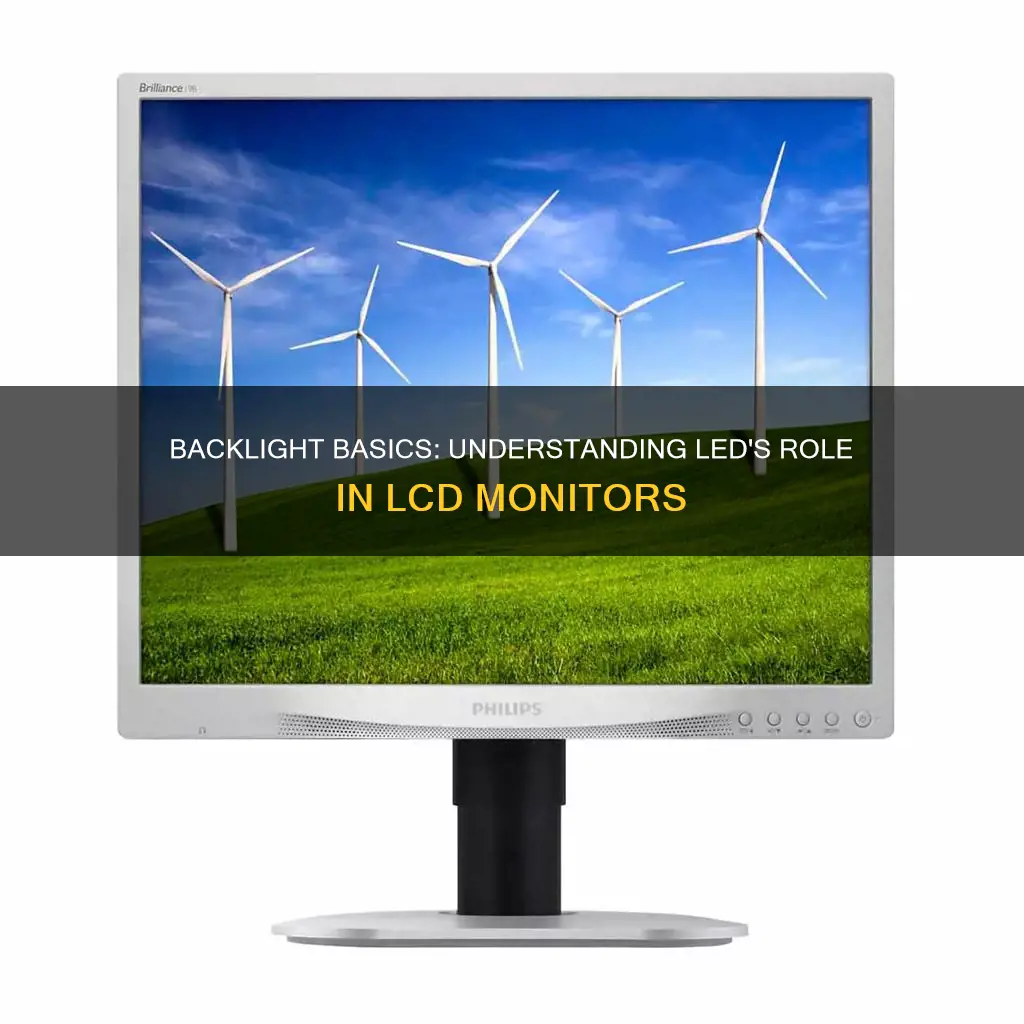
When shopping for a new monitor, you will often come across the terms LCD and LED. The main difference between the two lies in their backlighting technology. LCD stands for Liquid Crystal Display, and it uses cold cathode fluorescent lamps (CCFLs) for backlighting. LED, or Light-Emitting Diode, monitors use light-emitting diodes for backlighting. Importantly, all LED monitors are a type of LCD monitor, and the term LED monitor is shorthand for LED-backlit LCD monitor.
| Characteristics | Values |
|---|---|
| Definition | LED-backlit LCD is a liquid-crystal display that uses LEDs for backlighting instead of traditional cold cathode fluorescent (CCFL) backlighting. |
| Comparison with CCFL-backlit LCDs | Wider colour gamut and dimming range, greater contrast ratio, very slim, significantly lighter and cooler, lower power consumption, longer lifespan. |
| Types of LED backlighting | Edge-lit (ELED), Direct-lit (DLED) or full-array |
| Types of LCD panels | TN (Twisted Nematic), VA (Vertical Alignment), IPS (In-Plane Switching) |
| Pros of LED LCD monitors | Thin and lightweight, short/fast response time, consistent brightness, backlight dimming option |
| Cons of LED LCD monitors | Some edge-lit LED monitors can be hard to see at certain viewing angles, expensive |
| Pros of CCFL LCD monitors | Cheaper than LED monitors |
| Cons of CCFL LCD monitors | Not as energy-efficient, not as even illumination, difficult to repair/maintain |
What You'll Learn

LED backlighting offers a wider colour gamut and dimming range
RGB-LED backlighting employs triads of red, green, and blue LEDs to create broad-spectrum white light. This results in a wider colour gamut and more precise colour reproduction compared to white LED backlighting, which uses white LEDs to generate the entire spectrum of colours. RGB-LED backlighting can produce a colour gamut that is even wider than that of WCG-CCFL backlighting, making it ideal for image processing and viewing extended colour gamuts.
QDEF, or Quantum Dot Enhancement Film, is another technology that enables LED backlighting to offer a wider colour gamut. QDEF uses a film of nanoscopic phosphors called Quantum Dots, which can be tuned to control the wavelengths of light emitted. This allows for the display of a wider range of colours, improving colour accuracy and brightness.
In addition to a wider colour gamut, LED backlighting also offers a greater dimming range compared to CCFL backlighting. This is due to the ability of LEDs to be switched on and off more quickly, allowing for very high contrast ratios and deeper blacks. LED backlighting also enables local dimming, where the brightness of specific areas of the screen can be adjusted independently, further enhancing the contrast and dynamic range of the display.
The combination of a wider colour gamut and greater dimming range results in a more dynamic and visually appealing image. This makes LED backlighting ideal for gaming, graphic design, and video editing, where colour accuracy and picture quality are crucial.
Straight Talk's Data Usage Monitoring: Why and What It Means
You may want to see also

LED backlights improve contrast ratios
The contrast ratio of an LED display refers to the difference between the brightest and darkest areas of the display, typically measured in terms of luminance. It represents the display's ability to produce distinct levels of brightness and darkness, enhancing the perceived image quality and depth. A higher contrast ratio results in more vibrant and visually striking images, allowing for better differentiation of details.
LED backlighting technology in monitors offers superior picture quality with better contrast ratios and deeper blacks compared to traditional LCD displays. LCD monitors can struggle to produce true blacks and may appear washed out, especially in darker scenes. LED backlights improve contrast ratios by providing higher luminance output and improved black level performance.
Furthermore, LED monitors with full-array backlighting, where LEDs are placed evenly across the entire screen, offer local dimming capabilities and improved contrast ratios. On the other hand, edge lighting, where LEDs are placed along the edges of the screen, results in thinner displays but potentially less uniform lighting.
In summary, LED backlights improve contrast ratios by providing higher brightness, achieving true blacks, minimizing light leakage, and enhancing luminance output. LED monitors with full-array backlighting and local dimming capabilities further enhance contrast ratios, resulting in superior picture quality and improved visual clarity.
Monitoring Sprint Hotspot Usage: A Comprehensive Guide
You may want to see also

LED backlit LCDs are thinner, lighter and use less power than CCFL LCDs
LED-backlit LCD monitors are thinner, lighter, and more energy-efficient than their CCFL LCD counterparts.
LED monitors are a type of LCD monitor, with the term "LED monitor" being shorthand for "LED-backlit LCD monitor". The main difference between the two lies in their backlighting technology. LCD monitors use cold cathode fluorescent lamps (CCFLs) for backlighting, while LED monitors use light-emitting diodes (LEDs).
LED-backlit LCDs are significantly thinner and lighter than CCFL LCDs. This is because LEDs are much smaller than CCFLs, allowing for thinner displays. The compact size of LEDs also enables more precise lighting control, resulting in a more evenly lit screen. LED-backlit LCDs can be up to 50% lighter than CCFL LCDs, making them easier to transport and mount.
In addition to being thinner and lighter, LED-backlit LCDs also consume less power. On average, they use 20-30% less power than CCFL LCDs. This lower power consumption can lead to reduced electricity bills and is more environmentally friendly. The reduced power usage does not compromise brightness, as LEDs require less power to produce the same level of brightness as CCFLs.
The benefits of LED-backlit LCDs over CCFL LCDs extend beyond thinness, weight, and power consumption. LED-backlit LCDs also offer improved picture quality, with better contrast ratios and colour accuracy. They have a longer lifespan, with LED backlights lasting 50,000 to 100,000 hours compared to 30,000 to 60,000 hours for CCFL backlights. Additionally, LED-backlit LCDs have easier maintenance and better visual clarity.
Monitoring App Usage: Regulating Screen Time and Freedom
You may want to see also

LED backlights last longer than CCFL bulbs
LED backlights offer a longer lifespan compared to traditional CCFL bulbs. While CCFL backlights in LCDs last around 30,000 to 60,000 hours, LED backlights typically last 50,000 to 100,000 hours. This extended lifespan not only reduces the need for frequent replacements but also contributes to the overall durability of the device.
The longevity of LED backlights can be attributed to their advanced technology. LEDs, or light-emitting diodes, are semiconductor devices that emit light when an electric current passes through them. This technology allows for more precise control over screen brightness and better power management, resulting in reduced power consumption. Additionally, LEDs do not contain mercury, an environmental pollutant found in CCFL lamps.
The superior energy efficiency of LED backlights further contributes to their longer lifespan. LED backlights consume 20-30% less power than CCFL backlights, leading to significant energy savings over time. This reduced power consumption not only benefits the environment but also translates to lower electricity bills for users.
Moreover, LED backlights offer improved visual performance. They provide enhanced colour accuracy, better contrast ratios, and brighter, more vibrant colours. This enhancement is due to the wider colour gamut offered by LEDs, resulting in a more immersive viewing experience.
In summary, LED backlights offer a longer lifespan than CCFL bulbs due to their advanced technology, superior energy efficiency, and improved visual performance. This extended lifespan makes LED backlights a more cost-effective, environmentally friendly, and visually appealing option for LCD monitors and displays.
Asus Monitor Manufacturers: Who Makes These Devices?
You may want to see also

LED backlights improve colour accuracy
Additionally, LED backlights offer greater contrast ratios and better colour reproduction compared to traditional CCFL backlights. This is due to the ability of LEDs to be switched on and off more quickly, allowing for very high contrast ratios and the production of deep blacks and high brightness.
Furthermore, LED backlights improve colour accuracy by providing more precise control over screen brightness. This is achieved through the use of local dimming, where the backlight is dynamically controlled using the video information to adjust its intensity in specific areas of the screen. This results in darker blacks and brighter whites, enhancing the overall image quality and improving colour accuracy.
Finally, LED backlights have a longer lifespan and are more energy-efficient than CCFL backlights. This is because LEDs consume less power, resulting in reduced electricity consumption and lower energy bills. The lower heat output of LEDs also contributes to their longer lifespan and provides a more comfortable viewing experience.
Overall, the combination of a wider colour gamut, higher contrast ratios, dynamic local dimming, improved energy efficiency, and longer lifespan makes LED backlights superior to CCFL backlights in terms of colour accuracy and overall display performance.
Monitoring Home Electricity Usage: A Guide for Indian Households
You may want to see also
Frequently asked questions
An LCD (Liquid Crystal Display) monitor is a flat-panel display that uses liquid crystal technology to produce images. They are characterised by their use of liquid crystals to control light passage, backlighting, and good colour reproduction and brightness.
An LED (Light Emitting Diode) monitor is a type of LCD monitor that uses light-emitting diodes for backlighting instead of traditional fluorescent lights. LED monitors offer improved visual clarity, colour accuracy, and better contrast ratios.
The main difference lies in their backlighting technology. LCD monitors use cold cathode fluorescent lamps (CCFLs) for backlighting, whereas LED monitors use light-emitting diodes. LED monitors are a type of LCD monitor, and the term "LED monitor" is shorthand for "LED-backlit LCD monitor".
For gaming, an LED monitor with full-array backlighting is usually the better choice due to higher contrast ratios, better colour accuracy, and faster response times. However, if you are on a budget, a high-quality LCD monitor can still provide a good gaming experience, especially with a high refresh rate.
Both LCD and LED monitors can cause eye strain with prolonged use. However, LED monitors often have better brightness control, reduced flicker, and blue light filtering options to mitigate this. Additionally, the lower power consumption of LED monitors can also help to reduce eye strain.







